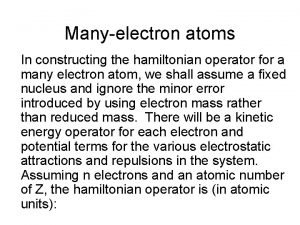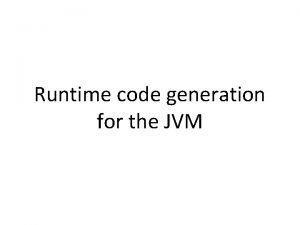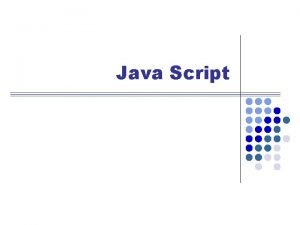What is Node JS A Java Script runtime









- Slides: 9

What is Node. JS? A Java. Script runtime environment running Google Chrome’s V 8 engine ◦ a. k. a. a server-side solution for JS ◦ Compiles JS, making it really fast Runs over the command line Designed for high concurrency ◦ Without threads or new processes Never blocks, not even for I/O Uses the Common. JS framework ◦ Making it a little closer to a real OO language

Concurrency: The Event Loop Instead of threads Node uses an event loop with a stack Alleviates overhead of context switching

Threads VS Event-driven Threads Asynchronous Event-driven Lock application / request with listener-workers threads only one thread, which repeatedly fetches an event Using incoming-request model Using queue and then processes it multithreaded server might block the request which might involve multiple events manually saves state and then goes on to process the next event Using context switching no contention and no context switches Using multithreading environments where listener and workers threads are used frequently to take an incomingrequest lock Using asynchronous I/O facilities (callbacks, not poll/select or O_NONBLOCK) environments

Event Loop Example Request for “index. html” comes in Stack unwinds and ev_loop goes to sleep File loads from disk and is sent to the client

Non-blocking I/O Servers do nothing but I/O ◦ Scripts waiting on I/O requests degrades performance To avoid blocking, Node makes use of the event driven nature of JS by attaching callbacks to I/O requests Scripts waiting on I/O waste no space because they get popped off the stack when their non-I/O related code finishes executing

I/O Example

Consistancy Use of JS on both the client and server-side should remove need to “context switch” ◦ Client-side JS makes heavy use of the DOM, no access to files/databases ◦ Server-side JS deals mostly in files/databases, no DOM JSDom project for Node works for simple tasks, but not much else

Node. js VS Apache 1. It's fast 2. It can handle tons of concurrent requests 3. It's written in Java. Script (which means you can use the same code server side and client side) Platform Number of request per second PHP ( via Apache) 3187, 27 Static ( via Apache ) 2966, 51 Node. js 5569, 30

References http: //nodejs. org/cinco_de_node. pdf http: //ajaxian. com/archives/google-chromechromium-and-v 8 http: //blog. chromium. org/2010/12/newcrankshaft-for-v 8. html http: //news. softpedia. com/news/IE 9 -RC-vs. Chrome-10 -9 -vs-Opera-11 -vs-Firefox-11 Performance-Comparison-183973. shtml

















